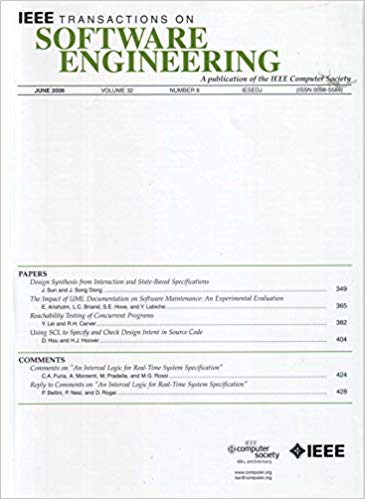Detecting Information Flow Security Vulnerabilities by Analysis Coupling
IF 5.6
1区 计算机科学
Q1 COMPUTER SCIENCE, SOFTWARE ENGINEERING
引用次数: 0
Abstract
Security vulnerabilities originating from insecure information flows can violate the confidentiality of data, thereby negatively impacting individuals and service providers. This challenge gave rise to design-level analyses and source code analyses investigating information flow-related vulnerabilities. Architectural analysis, a type of design-level analysis, can detect security vulnerabilities by inspecting architectural models enriched with specifications of security-relevant information. However, the implementation may not comply with the architectural specification during software evolution. This non-compliance can result in the architectural analysis missing vulnerabilities. Consequently, vulnerabilities in the deployed system can be exploited, but the software engineers are left assuming the system to be secure. In this article, we address this problem of specification-related non-compliance by proposing a coupling approach that enables architectural analyses to use the values of security characteristics which are supplied from the implementation and retrieved by static source code analysis. Our coupling approach makes two contributions: a coupling process and the conditions necessary for the coupling (called integration conditions). In our coupling process, each process step performs transformations between the involved input and output models of the analyses. To enable the coupling, we define necessary integration conditions that must hold between the (meta)models of the analyses in the coupling. We generalize from specific analyses by specifying the integration conditions based on reference metamodels. In our evaluation, we inspect (1) the coverage of the reference metamodels by the metamodels of coupled analyses, (2) the coverage of the integration conditions by successful couplings, and (3) the accuracy of the coupled analysis in finding architectural vulnerabilities originating from a non-compliant implementation. The results of our case study show that the reference metamodels and the integration conditions are covered. We detect 60 true positive vulnerabilities and 5 false positive vulnerabilities. Upon this evidence, we conclude that the architectural analysis in the coupling is accurate in detecting vulnerabilities originating from non-compliant information flows in the implementation.利用分析耦合检测信息流安全漏洞
源自不安全信息流的安全漏洞可能违反数据的机密性,从而对个人和服务提供商产生负面影响。这一挑战产生了设计级分析和源代码分析,用于调查与信息流相关的漏洞。体系结构分析是一种设计级分析,可以通过检查具有安全相关信息规范的体系结构模型来检测安全漏洞。然而,在软件发展过程中,实现可能不符合体系结构规范。这种不遵从性可能导致架构分析遗漏漏洞。因此,可以利用已部署系统中的漏洞,但软件工程师仍然假定系统是安全的。在本文中,我们通过提出一种耦合方法来解决与规范相关的不遵从性问题,该方法使体系结构分析能够使用由实现提供并由静态源代码分析检索的安全特征值。我们的耦合方法做出了两个贡献:耦合过程和耦合所需的条件(称为集成条件)。在我们的耦合过程中,每个过程步骤执行分析的相关输入和输出模型之间的转换。为了启用耦合,我们定义了必要的集成条件,这些条件必须在耦合中的分析(元)模型之间保持。我们通过在参考元模型的基础上指定集成条件,从具体分析中进行归纳。在我们的评估中,我们检查了(1)耦合分析的元模型对参考元模型的覆盖,(2)成功耦合对集成条件的覆盖,以及(3)耦合分析在发现源自不兼容实现的体系结构漏洞方面的准确性。我们的案例研究结果表明,参考元模型和集成条件被涵盖。我们检测到60个真阳性漏洞和5个假阳性漏洞。根据这些证据,我们得出结论,耦合中的体系结构分析在检测来自实现中不兼容信息流的漏洞方面是准确的。
本文章由计算机程序翻译,如有差异,请以英文原文为准。
求助全文
约1分钟内获得全文
求助全文
来源期刊

IEEE Transactions on Software Engineering
工程技术-工程:电子与电气
CiteScore
9.70
自引率
10.80%
发文量
724
审稿时长
6 months
期刊介绍:
IEEE Transactions on Software Engineering seeks contributions comprising well-defined theoretical results and empirical studies with potential impacts on software construction, analysis, or management. The scope of this Transactions extends from fundamental mechanisms to the development of principles and their application in specific environments. Specific topic areas include:
a) Development and maintenance methods and models: Techniques and principles for specifying, designing, and implementing software systems, encompassing notations and process models.
b) Assessment methods: Software tests, validation, reliability models, test and diagnosis procedures, software redundancy, design for error control, and measurements and evaluation of process and product aspects.
c) Software project management: Productivity factors, cost models, schedule and organizational issues, and standards.
d) Tools and environments: Specific tools, integrated tool environments, associated architectures, databases, and parallel and distributed processing issues.
e) System issues: Hardware-software trade-offs.
f) State-of-the-art surveys: Syntheses and comprehensive reviews of the historical development within specific areas of interest.
 求助内容:
求助内容: 应助结果提醒方式:
应助结果提醒方式:


